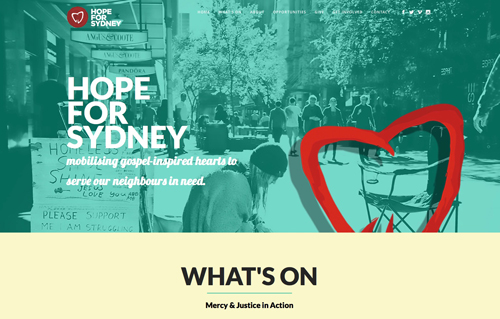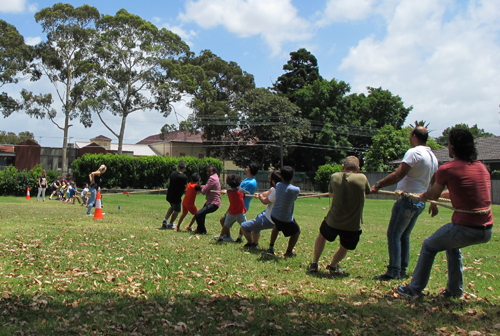
Since 2012, Hope for Sydney has been helping Christians get involved in helping others. DAVID ADAMS reports on a movement aimed at putting willing hands to the work of the Gospel…
It’s something some churches are particularly good at – getting involved in charitable works to help others. Other churches, not so much. Hope for Sydney aims to help change that by engaging young adult Christians – people aged in their 20s or early 30s – to get involved in helping others.
“When it comes to that young adults group in particular, they are looking to do something meaningful in serving in the mercy and justice-type space but they don’t know where to go, what to do, how to begin,” says Helen Kim, Hope for Sydney’s executive director. “And I think these questions are still prevalent.”


SHARING LOVE: The Hope for Sydney website and volunteers get involved in a tug-of-war during a day to get alongside asylum-seekers in Sydney.
“Pastors are helped, because they don’t have to do the research. The Gospel is served, since the requirement [on] partnering organisations is that the Gospel can be preached. But most of all, Hope for Sydney is not just a portal for servants, but fuel to get people serving and loving and caring for their neighbours.”
– Rev Justin Moffatt, who founded Hope for Sydney, in 2012.
Hope for Sydney is modeled after a US-based organisation Hope for New York – a ministry affiliated with a number of churches including Redeemer Presbyterian Church (led by Tim Keller). The Sydney organisation was founded in 2012 by Rev Justin Moffatt, rector of Church Hill Anglican parish in Sydney, which takes in both St Philip’s Church and The Garrison Church.
Rev Moffatt, who is married to an American, Dr Laurel Moffatt, encountered Hope for New York while living in the city between 2005 and 2009. He had joined the staff of a church in Manhattan which had originally been resourced by Redeemer and which was connected to Hope for New York, a fact which led him to serve at a homeless shelter. So impressed was he by what he encountered that he brought the idea back to Sydney.
“I saw it work in NYC with Hope for New York,” he says in an email to Sight. “I knew that there are many differences between NYC and Sydney, but I still could simply see it work. Along with many others, I could see that there [was] a mission implications of the Gospel that ought to lead those who know Christ to serve the poor, lonely, marginalised, and suffering. And I could see that churches were limited in their resources to help.”
Rev Moffatt says he was inspired by Dr Keller’s approach to church as ‘gathered’ and ‘scattered’.
“The church, as it gathers, must not prioritise mercy ministries, since the church’s task is teaching, preaching and discipleship. But the ‘church scattered’ can do remarkable things as individuals and small groups interact, love, serve, and, most importantly, share Christ with those who experience suffering, ageing, mental health, and injustice. Instead of staying at home and watching another series of West Wing, they get out and serve vulnerable people as servants of Jesus Christ.”
Hope for Sydney was started with some seed funding from Church Hill Anglican but, says Rev Moffatt, it “had to be a separate organisation: both in governance and in funding” from the start if it was to work. It is now funded through donations from individuals and foundations.
Ms Kim say the aim is to “build a movement of change for Christian involvement in charitable service, like direct interactive service.”
Close to 400 volunteers have been involved to date in the Sydney initiative – generally single people aged from their 20s into the early 30s (although some volunteers have young families) – and they have come from as many as 80 different churches.
Through 14 partner organisations they have been involved in projects aimed at supporting the homeless, asylum seekers/refugees and the elderly. Activities have included attending an annual barbeque with asylum seekers (via partner agency Marist Youth Care), sharing a bi-monthly meal with the homeless (via City Care Lunch at St Philip’s Anglican Church), supporting trafficked people (via Freedom Hub) and aiding in construction and landscaping projects for the disadvantaged (via partner agency Habitat for Humanity)
“I’m driven by activities that are interactive and not so much removed,” says Ms Kim, an American who has a background in public policy. “I’ll avoid things like putting hampers together or fundraising for an organisation. While those things are necessary…and good activities, I’m trying to get past that.”
Ms Kim says the focus at present is to build partnerships with local churches to offer congregants the opportunity to become involved as a group. It’s estimated that about 20 different churches have responded positively to the idea.
She adds that while she’s unaware of whether young adults are more or less involved in charitable works that other age groups, there’s definitely a need for more to get involved.
She recalls her experience as young worker living in New York City wondering if there was more to life than just work.
“You have some time and you have a sense of justice or wanting to participate in your faith differently than [just] showing up on Sundays,” she says. “And so there’s that unique time in your life when you have the time and you have the drive and the curiosity to do something.”
For Rev Moffatt, meanwhile, the benefits of Hope for Sydney are several. He illustrates by recounting an incident a number of years ago in which he was approached by a young man called Adam and asked how he could serve the poor.
“To be honest, I didn’t know,” he says. “And I didn’t feel like I had the time to find a place for him to serve. I was busy enough! The key benefit of Hope for Sydney is that people like Adam can find a place to serve. Pastors are helped, because they don’t have to do the research. The Gospel is served, since the requirement [on] partnering organisations is that the Gospel can be preached. But most of all, Hope for Sydney is not just a portal for servants, but fuel to get people serving and loving and caring for their neighbours.”




